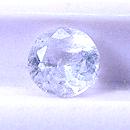|
|
||||||||||||||||
|
||||||||||||||||
|
||||||
|
|
|
|
Bertrandite
|
|
| | |
| Discovered in 1883; IMA status: Valid (pre-IMA; Grandfathered) | ||
|
| ||
|
Chemistry |
|
|
| |
|
Be4(Si2O7)(OH)2 | |
|
|
Beryllium Silicate Hydroxide |
|
Molecular Weight: |
238.23 gm |
|
Composition: |
Beryllium |
15.13 % |
Be |
42.00 % |
BeO |
|
|
Silicon |
23.58 % |
Si |
50.44 % |
SiO2 |
|
|
Hydrogen |
0.85 % |
H |
7.56 % |
H2O |
|
|
Oxygen |
60.44 % |
O |
|
|
|
|
|
100.00 % |
|
100.00 % |
= TOTAL OXIDE |
|
|
|
||||
|
Classification |
|
|
| |
|
Silicates (Germanates) | |
|
8/C.07-10 | |
|
|
9 : SILICATES (Germanates)
|
|
Related to: |
Bertrandite-Strontiochevkinite Series. |
|
Varieties: |
Gel-Bertrandite |
|
Synonyms: |
Hessenbergite |
|
|
|
|
Crystal Data |
|
|
|
|
|
Crystals thin tabular, commonly prismatic to needlelike, to 5 cm; in radial aggregates. |
|
|
Common on [011] or [021]; twins heart-shaped or V-shaped with axes crossing at angles of about 60° and 120°. |
|
|
|
|
|
Physical Properties |
|
|
|
|
|
Perfect on {001}; Distinct on {100}, {010}, and {110} |
|
|
n/a |
|
|
Brittle |
|
|
6.0 - 7.0 |
|
|
2.59 - 2.60 (g/cm3) |
|
|
None |
|
|
Not Radioactive |
|
|
Other: | |
|
|
|
|
Optical Properties |
|
|
|
|
|
Colorless, pale Yellow |
|
|
Translucent to Transparent |
|
|
Vitreous, Pearly on cleavage {001} |
|
|
1.583 - 1.614 Biaxial ( - ) |
|
|
0.0230 |
|
|
Weak; r < v |
|
|
None |
|
|
|
|
|
Occurances |
|
|
|
|
|
Geological Setting: |
In fissures in granites and associated pegmatites and in miarolitic cavities in greisens; commonly an alteration product of beryl, more rarely as a primary mineral. |
|
Common Associations: |
Beryl, Fluorite, Herderite, Muscovite, Phenakite, Quartz, Tourmaline. |
|
Common Impurities: |
Al, Fe, Ca |
|
Co-Type Localities: |
Barbin Quarry, Nantes, Loire-Atlantique, Pays de Loire,
France; |
|
Year Discovered: |
1883 |
|
View mineral photos: | |
|
|
|
|
More Information |
|
|
|
|
|
| |
|
|
|
|
Bertrandite
is found in small amounts at numerous localities but
gem quality crystals are rare. A few locations include
Golconda mine, near Governador Valadares, Minas Gerais,
Brazil; Barbin quarries at Petit-Port, Loire-Atlantique,
France; Akchatau, Kara-Oba, and Kounrad, Kazakhstan;
and in the USA on Mt. Antero, Chaffee County, Colorado;
at the Strickland quarry, Portland, Middlesex County,
Connecticut. |
|
|
We
have not photographed our Bertrandite gems
yet. Please
check back soon. |
